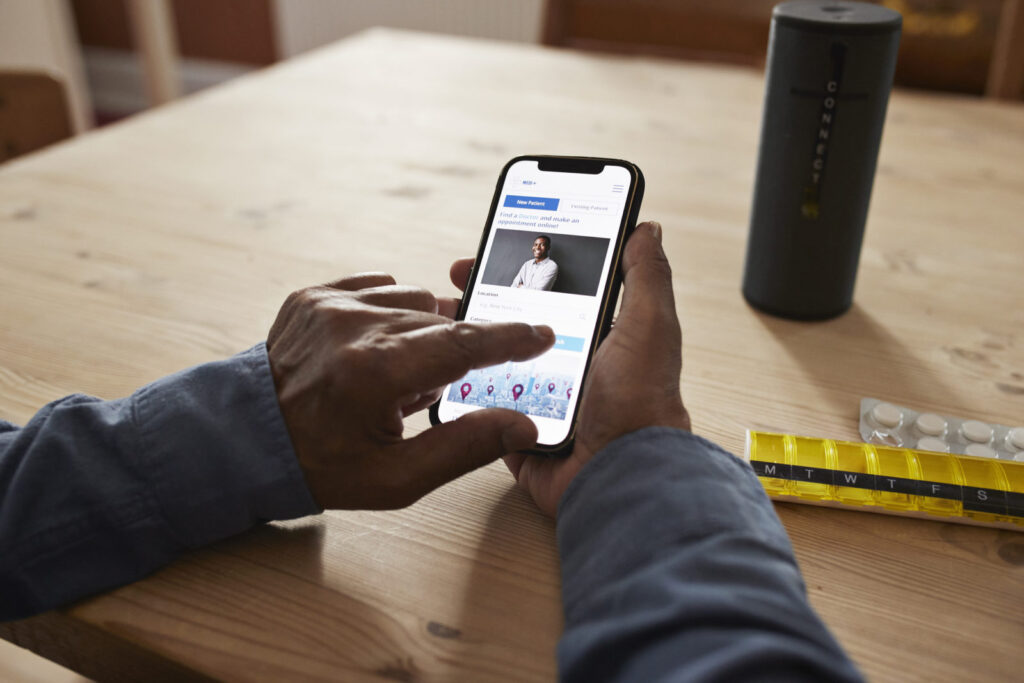
A report published in August 2022 suggested that 46% of all U.S. consumers had used a mix of digital and in-person healthcare services. That included two-thirds of Gen Z and millennial consumers, one-half of bridge millennials (those born between 1980–1989), and well over one-quarter of baby boomers and seniors.
Welcome to omnichannel healthcare, or what a new report from Accenture and AdvaMed calls a key trend of “Care Anywhere, Everywhere.”
A Flurry of Opening Digital Front Doors for Health
In the second half of 2022, a flurry of market announcements paints the fast-moving picture—well, less picture and more animated video—of omnichannel health developments:
- Amazon Care, the company’s urgent care venture, will shut down at the end of 2022—but the e-commerce giant isn’t finished in the healthcare space. Amazon Clinic, positioned as a text-based digital front door for primary care, launched earlier this month. The messaging-driven service will link consumers to clinical help for at least 20 common conditions, such as acne, dandruff, and eczema as well as erectile dysfunction, urinary tract and yeast infections, and genital herpes.
- CVS Health acquired SignifyHealth (an $8 billion deal), expanding the reach into patients’ homes through a network of physicians, nurse practitioners and physical assistants. Signify Health already operates a hybrid-care model with in-person and virtual visits.
- Best Buy invested in Coeus h3c for streamlining the technology for remote health monitoring to peoples’ homes. The enabling tech for this is h3c’s Home Health Hybrid Cloud (or h/c) designed to make implementing RPM in consumers’ home easier.
“We’re committed to enabling care at home for everyone, and we’re continually seeking new ways to apply our core capabilities in omnichannel retail, in-home services, logistics, caring centers and technology with our leading home health solutions for wellness, aging in place and managing health conditions at home,” explained Debbie DiSanzo, president of Best Buy Health.
- GenieMD and Lifestyle Health Rx are partnering to deliver virtual healthcare services to senior residents of the Villages, one of the largest retirement communities in the U.S. The program will channel lab services to the home, prescription drug delivery, telehealth visits to a medical provider network, and access to electronic health records to the “Villagers” living in the community.
- Instacart launched Instacart Health during the White House Conference on Hunger, Nutrition and Health. The grocery delivery company’s initiative will work on nutrition security, food-as-medicine, and wellness initiatives collaborating with hospitals, clinicians, business and other stakeholders to champion nutrition for “all.”
Together, this handful of examples among dozens of others herald the emerging era of hybrid healthcare. This is care delivered via omnichannel, a retail life-flow that consumers have been getting used to for sourcing groceries, music, and financial services.
Those are industries whose experiences consumers also highly value. According to the latest ACSI Index on customer experience, U.S. consumers rank healthcare experiences (for hospitals and health plans) in the bottom one-third of their daily touchpoints—akin to the ranks of social media, landline phone services and gas stations.
Hybrid Care—Accelerating Through the Pandemic
The COVID-19 pandemic ushered in a plethora of digital front doors for consumers, patients and caregivers seeking engagement from a health system that kept them at a distance in the initial lock-down phase followed by a long tail of “medical distancing.”
IQVIA identified a portfolio of digital health tools used in the patient journey during the coronavirus pandemic, which included consumer wearables, connected biometric sensors, smartphone cameras, clinical trial tools enabling virtual trials, in-home connected virtual assistants, web-based interactive programs, care team email and text messaging, disease management apps, consumer mobile apps, and of course, telemedicine and virtual physician visits.
“The distinction between online and in-person experiences is becoming less and less definitive,” Dr. Peter Antall, a telehealth pioneer, recently wrote. “In healthcare, hybrid care models combine virtual and in-person experiences across the full continuum of care.”
How a Health Insurer Connected the Dots to Morph into a Hybrid Care Provider
Let’s consider an example of how those experiences can get connected across that full continuum of care. Take Cigna as an illustration.
Start with some data that informed Cigna’s hybrid strategy. Evernorth, a Cigna operating company, surveyed U.S. consumers’, health plan and HR leaders’ perspectives on hybrid care. Most people expected to take advantage of both digital and physical, in-person services in the future, the study found.
Over the next couple of years, most payers (plans and employers) will prioritize virtual care and digital care management tools as the top two hybrid care components. In addition, company onsite clinics, home care, retail clinics, and self-service triage will round out payers’ portfolio mix of hybrid care “front doors.”
Plans and HR leaders also noted that virtual care services would indeed cover a continuum of primary care, specialty care, urgent care, nutrition, occupational therapy and speech therapy, Evernorth’s research confirmed.
Next, for the dot-connecting: Evernorth was launched by Cigna in 2020 to deliver health service innovations beyond the company’s core health insurance business. To extend the hybrid care platform, Evernorth acquired MDLIVE, the virtual care company, in 2021. In November 2022, Evernorth began collaborating with VillageMD to channel primary care services to patients.
VillageMD is a national (U.S.) provider of primary care services; Walgreens increased its investment in VillageMD in 2021, bringing its ownership stake up to 63%. The plan for that capital influx was to grow the number of Walgreens pharmacy co-located primary care practices to at least 600 in more than 30 U.S. markets by 2025, and 1,000 by 2027.
Now, don’t blink: In early November, VillageMD acquired Summit Health-City MD, with financial support from Walgreens and Evernorth. This combination bolstered VillageMD’ s primary care footprint and, ultimately, Cigna’s hybrid health services portfolio and reach.
As Joan Harvey, Evernorth’s president, Care Solutions, explained in the Health Care in Focus report, “We have seen tremendous growth in direct to customer health care services. We can provide plan sponsors with the insights and clinical support members need to navigate and connect to the right level of care, which in return, leads to greater plan savings.”
Thus, as with so many of the recent announcements the likes of which led this essay, the over-arching of the hybrid care strategy is to position the organization for value-based care.
Building Equity into Hybrid Care
In collaboration with Manatt, the AMA just published a blueprint for optimizing digitally enabled care—signaling the physician association’s interest in scaling telehealth and other flavors of digital health tools that re-center care around the patient-physician relationship as well as reduce fragmentation. That will be key for ensuring a trust-building customer experience for patients and a wellbeing bolster for clinicians in this era of burnout and higher anxiety.
The AMA blueprint also calls out designing with a lens on health equity. “As we build new and integrated care models for the future, it is crucial to focus on patients’ different circumstance—including age, gender, race, language, and other social determinants of health— and ensure that digital tools are used as a bridge to more equitable care,” the AMA asserts.
Impact on health equity is a “fundamental metric” that should be used in assessing the value created by all health innovations, the AMA says.
Health equity converges with a digital divide for many people, resulting in a “techquity” gap. Connectivity is increasingly recognized as a driver of health, financial, and educational well-being. This JAMIA column titled “TechQuity is an imperative for health and technology business” called for equity and social justice as a technology business strategy, inspiring partnerships across industries that can solve for inequities.
To more effectively reach members and address health equity, a multi-channel engagement approach is necessary, Abner Mason, founder of SameSky Health and a member of the AMA Center for Health Equity, has learned. That multi-channel approach is also underpinned by collaborations between legacy healthcare stakeholders, retail health providers, food and grocery stores (including ecommerce channels), and other trusted community healthcare touchpoints.
“Member engagement involves the use of multi-channel electronic communications (live calls, text messages, and email) designed to engage and involve members in specific aspects of their health,” Mason explained in an interview with Onboard Health.
“I hope healthcare becomes personalized as so many other industries have advanced to a very individualized, tailored experience for people based on their behaviors, likes, dislikes, personal preferences, and other factors.”
That’s the promise of omnichannel consumer experiences delivered by other industries, as the ACSI consumer experience data has shown us. It’s the opportunity for hybrid healthcare, as well.


About The Author: Jane Sarasohn-Kahn, MA, MHSA
Through the lens of a health economist, Jane defines health broadly, working with organizations at the intersection of consumers, technology, health and healthcare. For over two decades, Jane has advised every industry that touches health including providers, payers, technology, pharmaceutical and life science, consumer goods, food, foundations and public sector.
More posts by Jane Sarasohn-Kahn, MA, MHSA